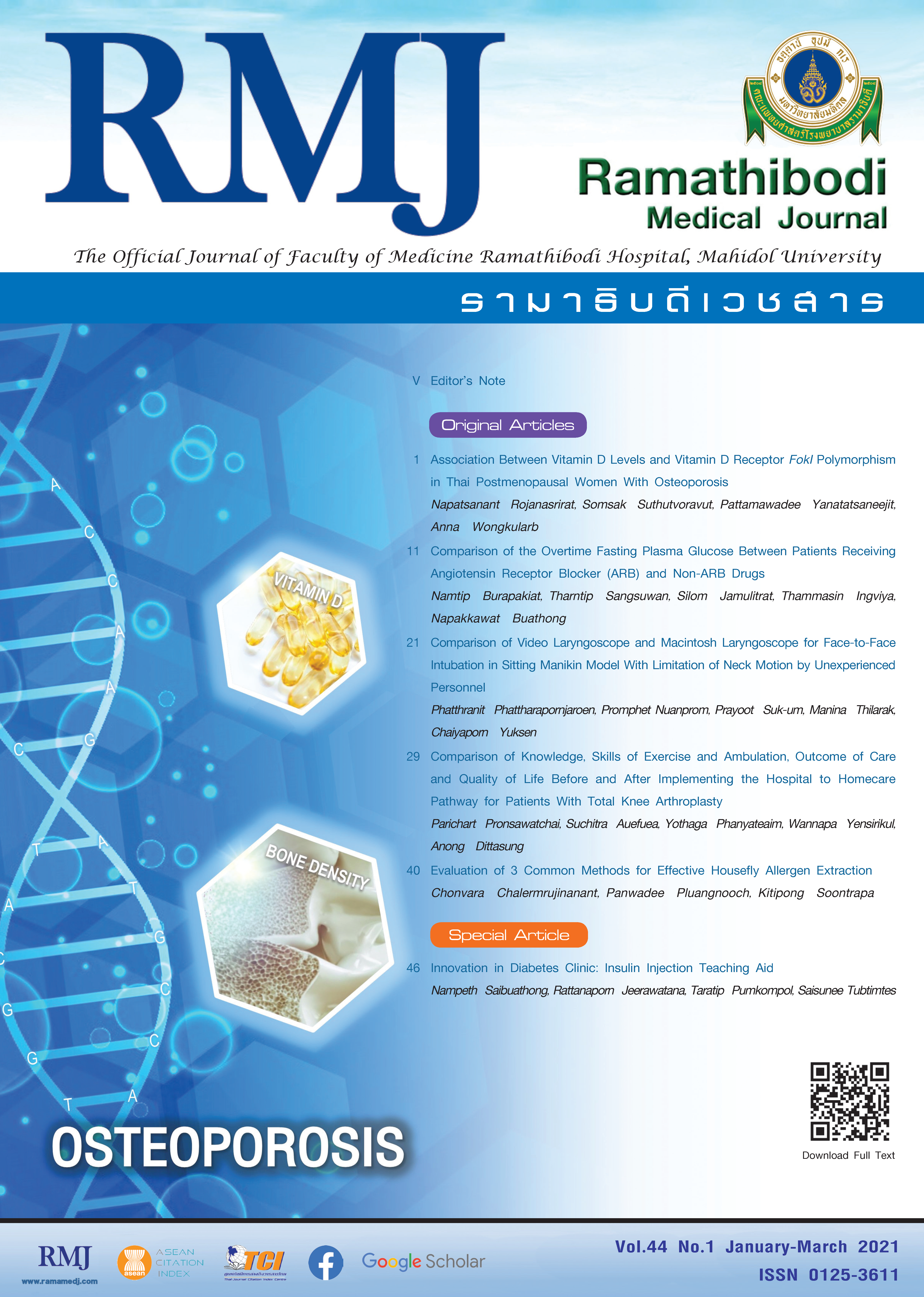Association Between Vitamin D Levels and Vitamin D Receptor FokI Polymorphism in Thai Postmenopausal Women With Osteoporosis
DOI:
https://doi.org/10.33165/rmj.2021.44.1.246575Keywords:
Osteoporosis, Postmenopausal, Vitamin D levels, Vitamin D receptor, FokI polymorphismAbstract
Background: Osteoporosis is a complex genetic disease, which is common among postmenopausal women. It is characterized by decreased bone mineral density (BMD) and increased bone fragility and fractures.
Objective: To study the association between serum vitamin D levels and vitamin D receptor (VDR) genetic FokI polymorphism in postmenopausal women with osteoporosis.
Methods: A total of 60 postmenopausal women who came for treatment at the menopausal clinic at Ramathibodi Hospital were enrolled. All of the patients had their BMD measured, and were determined serum vitamin D levels and VDR FokI polymorphism. Data were analyzed using chi-square and Fisher exact tests. The frequency of single nucleotide polymorphism (SNP) with risk of osteoporosis was compared.
Results: Among 60 postmenopausal women, 26 (43.3%) women were an osteoporotic group and 34 (56.7%) women were non-osteoporotic group. There were no significant differences in age, vitamin D levels, or VDR FokI polymorphism between the groups (P > .05). However, the TT genotype of VDR FokI polymorphism was significantly associated with vitamin D deficiency (< 20 ng/mL) (OR, 6.15; 95% CI, 1.51 - 25.14; P < .05).
Conclusions: Vitamin D levels and genotype of VDR FokI polymorphisms were similar between the osteoporotic and non-osteoporotic postmenopausal women. The TT genotype of VDR FokI polymorphism showed a significant association with vitamin D deficiency. Therefore, TT genotype of VDR FokI polymorphism may be used to predict risk of vitamin D deficiency.
References
Melton LJ 3rd, Chrischilles EA, Cooper C, Lane AW, Riggs BL. Perspective. How many women have osteoporosis? J Bone Miner Res. 1992;7(9):1005-1010. doi:10.1002/jbmr.5650070902
Riggs BL. Vitamin D-receptor genotypes and bone density. New Engl J Med. 1997;337(2):125-126. doi:10.1056/nejm199707103370210
WHO Scientific Group on the Prevention and Management of Osteoporosis. Prevention and Management of Osteoporosis: Report of a WHO Scientific Group. World Health Organization; 2003. Accessed October 21, 2020. https://apps.who.int/iris/handle/10665/42841
Cooper C, Campion G, Melton LJ 3rd. Hip fractures in the elderly: a world-wide projection. Osteoporos Int. 1992;2(6):285-289. doi:10.1007/BF01623184
Gullberg B, Johnell O, Kanis JA. World-wide projections for hip fracture. Osteoporos Int. 1997;7(5):407-413. doi:10.1007/pl00004148
Holick MF. Vitamin D deficiency. N Engl J Med. 2007;357(3):266-281. doi:10.1056/NEJMra070553
Turner AG, Anderson PH, Morris HA. Vitamin D and bone health. Scand J Clin Lab Invest Suppl. 2012;243:65-72. doi:10.3109/00365513.2012.681963
Fuleihan GE. Vitamin D deficiency in the Middle East and its health consequences for children and adults. Clin Rev Bone Miner Metab. 2009;7:77-93. doi:10.1007/s12018-009-9027-9
Cashman KD, Dowling KG, Škrabáková Z, et al. Vitamin D deficiency in Europe: pandemic? Am J Clin Nutr. 2016;103(4):1033-1044. doi:10.3945/ajcn.115.120873
Vaishya R, Vijay V, Agarwal AK, Jahangir J. Resurgence of vitamin D: old wine in new bottle. J Clin Orthop Trauma. 2015;6(3):173-183. doi:10.1016/j.jcot.2015.02.002
Prentice A. Nutritional rickets around the world. J Steroid Biochem Mol Biol. 2013;136:201-206. doi:10.1016/j.jsbmb.2012.11.018
Saggese G, Vierucci F, Boot AM, et al. Vitamin D in childhood and adolescence: an expert position statement. Eur J Pediatr. 2015;174(5):565-576. doi:10.1007/s00431-015-2524-6
Thomas MK, Demay MB. Vitamin D deficiency and disorders of vitamin D metabolism. Endocrinol Metab Clin North Am. 2000;29(3):611-627. doi:10.1016/s0889-8529(05)70153-5
Morrison NA, George PM, Vaughan T, Tilyard MW, Frampton CM, Gilchrist NL. Vitamin D receptor genotypes influence the success of calcitriol therapy for recurrent vertebral fracture in osteoporosis. Pharmacogenet Genomics. 2005;15(2):127-135. doi:10.1097/01213011-200502000-00008
Soontrapa S, Soontrapa S, Chailurkit L, et al. Prevalence of vitamin D deficiency among postmenopausal women at Srinagarind Hospital, Khon Kaen Province, Thailand. Srinagarind Med J. 2006;21(1):23-29.
Smith CL, O'Malley BW. Coregulator function: a key to understanding tissue specificity of selective receptor modulators. Endocr Rev. 2004;25(1):45-71. doi:10.1210/er.2003-0023
Qin G, Dong Z, Zeng P, Liu M, Liao X. Association of vitamin D receptor BsmI gene polymorphism with risk of osteoporosis: a meta-analysis of 41 studies. Mol Biol Rep. 2013;40(1):497-506. doi:10.1007/s11033-012-2086-x
Wrzosek M, Jakubczyk A, Wrzosek M, et al. Association between Fok I vitamin D receptor gene (VDR) polymorphism and impulsivity in alcohol-dependent patients. Mol Biol Rep. 2014;41(11):7223-7228. doi:10.1007/s11033-014-3607-6
Techapatiphandee M, Tammachote N, Tammachote R, Wongkularb A, Yanatatsaneejit P. VDR and TNFSF11 polymorphisms are associated with osteoporosis in Thai patients. Biomed Rep. 2018;9(4):350-356. doi:10.3892/br.2018.1137
Sadat-Ali M, Al Elq AH, Al-Turki HA, Al-Mulhim FA, Al-Ali AK. Influence of vitamin D levels on bone mineral density and osteoporosis. Ann Saudi Med. 2011;31(6):602-608. doi:10.4103/0256-4947.87097
Capatina C, Carsote M, Caragheorgheopol A, Poiana C, Berteanu M. Vitamin D deficiency in postmenopausal women-biological correlates. Maedica. 2014;9(4):316-322.
Bassil D, Rahme M, Hoteit M, Fuleihan Gel-H. Hypovitaminosis D in the Middle East and North Africa: prevalence, risk factors and impact on outcomes. Dermatoendocrinol. 2013;5(2):274-298. doi:10.4161/derm.25111
Gallagher JC. Vitamin D and aging. Endocrinol Metab Clin North Am. 2013;42(2):319-332. doi:10.1016/j.ecl.2013.02.004
Smotkin-Tangorra M, Purushothaman R, Gupta A, Nejati G, Anhalt H, Ten S. Prevalence of vitamin D insufficiency in obese children and adolescents. J Pediatr Endocrinol Metab. 2007;20(7):817-823. doi:10.1515/jpem.2007.20.7.817
Zhao B, Zhang W, Du S, Zhou Z. Vitamin D receptor BsmI polymorphism and osteoporosis risk in post-menopausal women. Arch Med Sci. 2016;12(1):25-30. doi:10.5114/aoms.2016.57475
Tuncel G, Temel SG, Ergoren MC. Strong association between VDR FokI (rs2228570) gene variant and serum vitamin D levels in Turkish Cypriots. Mol Biol Rep. 2019;46(3):3349-3355. doi:10.1007/s11033-019-04796-6
Lucotte G, Mercier G, Burckel A. The vitamin D receptor FokI start codon polymorphism and bone mineral density in osteoporotic postmenopausal French women. Clin Genet. 1999;56(3):221-224. doi:10.1034/j.1399-0004.1999.560307.x
Choi YM, Jun JK, Choe J, et al. Association of the vitamin D receptor start codon polymorphism (FokI) with bone mineral density in postmenopausal Korean women. J Hum Genet. 2000;45(5):280-283. doi:10.1007/s100380070016
Mitra S, Desai M, Ikram Khatkhatay M. Vitamin D receptor gene polymorphisms and bone mineral density in postmenopausal Indian women. Maturitas. 2006;55(1):27-35. doi:10.1016/j.maturitas.2006.01.003

















